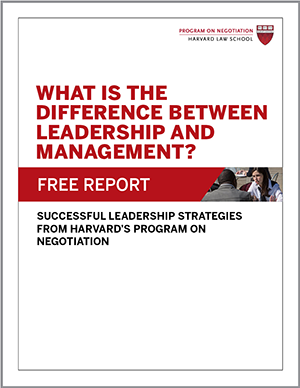
Servant leadership is powerful. Billionaire Warren Buffett is not particularly interested in making more money for himself. At 85 years old, he has amassed a staggering fortune, worth over $65 billion. Instead, what has consumed him for the last six years is how to give it all away, and how to convince other billionaires to do the same.
Back in 2010, Buffett created the Giving Pledge, an ambitious initiative designed to encourage the world’s wealthiest people to commit to donating half their fortune to charity within their lifetime. While it may be tempting to view his effort as a simple philanthropic exercise in transactional leadership, Buffett’s work shows how a careful use of negotiation can transform something straightforward into a higher cause through servant leadership.
Over the years, Buffett came to believe that his vast fortune could be put to use solving some of the world’s most challenging problems, and he thought that fellow billionaires should give back too. Yet, while a leader’s total devotion to a cause greater than themselves lies at the heart of the concept of servant leadership, it is not always enough to persuade others to take action. Effective servant leadership often employs fundamental negotiation skills in order to convince others to come on board. In a past feature on “60 Minutes,” Buffett shared the story of his efforts at negotiating to build the success of the Giving Pledge.
Envision a Target and “Map Backward”
Even with extraordinary influence and power, Buffett’s was not an easy task to envision achieving. While servant leadership is characterized by service to an effort above and beyond one’s own self, effective servant leaders also understand that success only comes from articulating their goals to others who can support them. They use strategies and tactics that will ensure that they get to their target deal.
With his goal in mind, Buffett pursued specific steps it would take to get there, using what negotiation scholars call “backward mapping.” Looking at where he wanted to end up and connecting it to where he was starting helped reveal the issues that mattered most to others and indicated the sequence of actions he would need to take to get them on board.
Think Coalitionally
In order to succeed, Buffett hoped to form a large coalition of philanthropists. He readily admitted that he did not have the personal skills to manage the actual steps of running a global philanthropic organization, and he knew that those skills would be necessary from the outset. By acknowledging this, Buffett was able to create a core constituency who would contribute skills and vision to the effort that he did not otherwise have.
Before announcing the initiative, Buffett recruited two friends—Bill and Melinda Gates—to help lead the Giving Pledge. An essential component of effective servant leadership is having the ability to honestly assess one’s own weaknesses and attempted to address them in ways that support building a stable coalition over time. By bringing the Gates’s on board, Buffett was able to overcome a barrier early on that would have impeded building the larger coalition that he ultimately needed.
Understand the Underlying Issues
Embracing servant leadership as part of your adaptive leadership does not automatically prove persuasive to others. Buffett needed to negotiate with dozens of fellow billionaires on an array of issues in order to succeed. In conversations, he made an effort to understand what mattered most to them. He discovered that there were many billionaires interested in giving away half their fortune or more, but that they were deeply resistant to the possibility that there would be restrictions on the definition of charity.
Buffett made the strategic decision that the Giving Pledge would be devoted to how to give money away rather than applying strict rules about who the money would be given to. Donors could pick and choose their own causes, based on their understanding of the needs of others. By making an effort to get at the core issues and responding accordingly, Buffett ultimately created a more appealing offer and avoided creating adversaries.
Don’t Run Away From the Negative
Buffett, the Gates’s, and their fellow philanthropists understood that committing to the Giving Pledge was a bold decision for many of their colleagues. By contributing, billionaires would draw attention, exposing themselves to scrutiny should the projects they supported ultimately fail. As effective negotiators, they responded by incorporated ways of addressing these potential barriers within the pledge, using them to create unexpected value that sustains the membership over time.
They created an ongoing set of forums, workshops, training, and gatherings for members to explore successful ways of giving, target their own goals, and learn from others. As Bill Gates told interviewer Charlie Rose, “we do think that we’re going to be smarter…doing it together.”
Be Comfortable with Criticism—Be Comfortable with ‘No’
Servant leadership comes with a healthy respect for timing, an ability to withstand criticism without resorting to petty tactics, and a capacity for accepting non-agreement. Along with praise, there has been some criticism of the Giving Pledge, and some billionaires have told Buffett and the Gates’s flatly that they will not sign on. While they do not dismiss opposition out of hand, they avoid making it into adversarial positions, focusing instead on getting the next set of donors on board.
As of April 2017, the Giving Pledge, which began as a club of three has expanded to 158 members, including Mark Zuckerberg and Priscilla Chan and includes business rivals like one-time Gates competitor and AOL co-founder Steve Case. As a result of years of negotiation and servant leadership, Buffett’s efforts have turned a fledgling idea into a half a trillion dollars of charitable giving.
What do you think about effective servant leadership methods? Leave us a comment.






Excellent distillation of how Warren Buffet took a simple but highly-impactful idea (dream), probably saw it already accomplished in his mind, then attracted others to it by listening intently to what matters most to them; then took focused action by masterminding with others who identified with his vision.